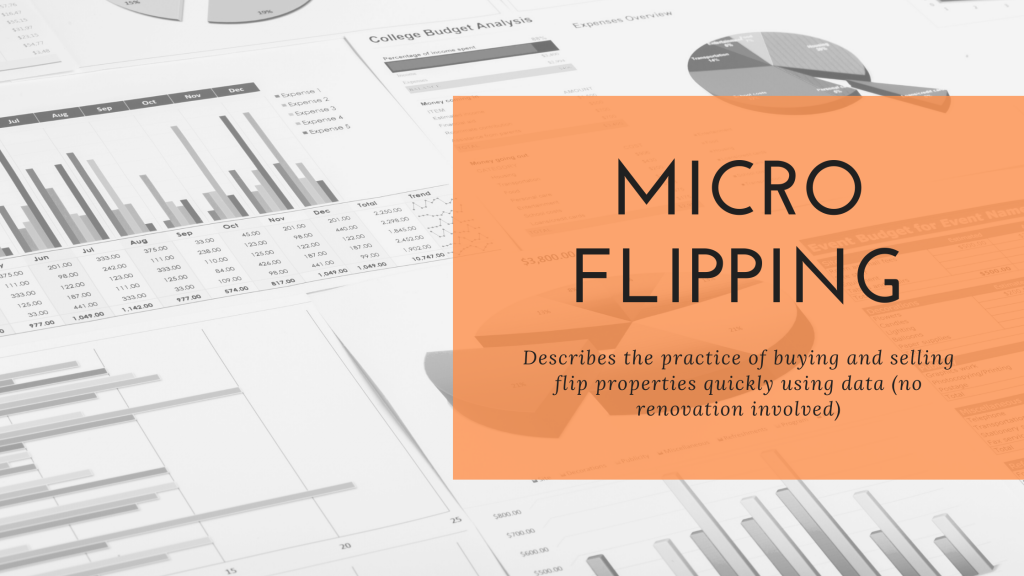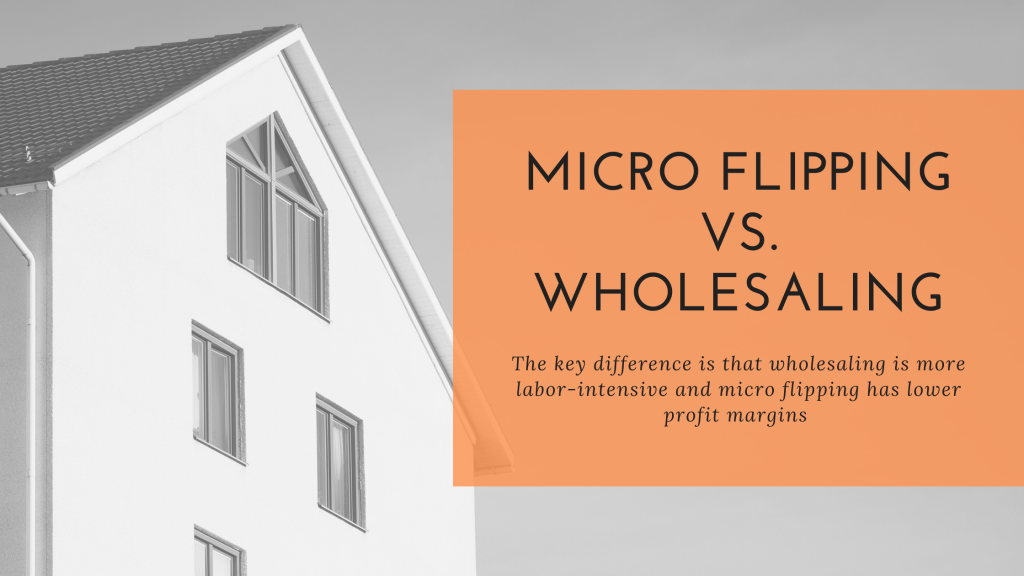Quick Summary
Micro flipping is revolutionizing real estate by eliminating the hassle of renovations, one of the most time-consuming and costly parts of traditional house flipping. Instead, investors use technology and data to buy and sell properties quickly, skipping the repairs entirely.
This strategy, often compared to online real estate wholesaling, leverages tech tools to find undervalued properties, acquire them, and resell to other buyers. It’s gaining traction among investors seeking a more passive approach to property flipping.
If you’re looking to break into the house-flipping industry without the heavy lifting, micro flipping could be the perfect entry point.
Table of Contents
What Is Micro Flipping?

Micro flipping is a fast-paced real estate strategy that leverages data and technology to buy and sell properties quickly, often within days. The “micro” refers to the speed of the process, allowing investors to profit without the need for time-consuming renovations. Transactions are streamlined, with some investors even securing buyers before purchasing a property, effectively pre-selling their deals. This reduces the risk of holding onto a property too long and ensures consistent profitability.
Unlike traditional house flipping, micro flipping focuses on properties that require minimal or no repairs. Instead of managing contractors or coordinating extensive renovations, micro flippers invest their time in data analysis and buyer outreach. Using advanced tools, they identify undervalued properties, acquire them, and pass on the deal to another buyer—typically someone looking for a longer-term investment or willing to handle renovations.
In micro flipping, the investor often doesn’t take full ownership of the property in the traditional sense. Instead, they are primarily dealing with contracts and rights associated with the property. Here’s what that means in more detail:
Selling the Contract, Not the Property
When a micro flipper identifies a profitable property, they typically secure it through a purchase agreement or contract to buy. This gives them the exclusive right to purchase the property at a set price within a specific timeframe. Instead of completing the purchase themselves, they sell or assign that contract to another buyer—usually an investor or end buyer—who will complete the transaction.
Why This Matters
This approach allows the micro flipper to:
- Avoid significant costs: They don’t need to secure full financing or pay for closing costs because they’re not holding the property.
- Minimize risks: They’re not responsible for the property if it doesn’t sell quickly or if its value drops.
- Accelerate the process: By focusing on selling the contract rather than the property, deals can be closed much faster.
Example of How Micro Flipping Works
- A micro flipper identifies a property listed at $150,000 but believes its market value is closer to $180,000.
- They negotiate a contract with the seller to buy the property for $150,000.
- Instead of purchasing the property themselves, they find another buyer (an investor or someone willing to renovate) who is willing to pay $160,000 for the deal.
- The micro flipper assigns the contract to the buyer for a $10,000 fee.
- The new buyer purchases the property from the seller at $150,000, and the micro flipper profits from the fee.
In this scenario, the micro flipper never owns the property—they profit from their role as a middleman who connects sellers and buyers while leveraging market insights and data.
Micro Flipping VS Wholesaling

From a broad perspective, micro flipping and wholesaling are very similar, as both involve sourcing and selling real estate contracts rather than holding or renovating properties. However, the differences lie in the approach, tools, and execution. Here’s an in-depth look at whether these distinctions are significant enough to separate the two:
Key Similarities
- No Renovations: Both strategies avoid renovations, focusing instead on identifying undervalued properties and passing them to buyers.
- Selling Contracts: Both involve assigning the right to purchase a property to another buyer, not selling the property itself.
- Investor as a Middleman: Both rely on acting as an intermediary between the seller and a buyer.
Key Differences
1. Use of Technology
- Micro Flipping: Heavily reliant on technology and data analytics tools. Micro flippers often use platforms and software to find undervalued properties and buyers quickly, which makes the process highly automated.
- Wholesaling: More manual and labor-intensive. Wholesalers traditionally rely on networking, door-knocking, direct mail campaigns, and cold-calling to find deals, which can take more time and effort.
2. Volume vs. Margin
- Micro Flipping: Operates on high volume and low margins, with a focus on turning over multiple deals quickly for smaller, consistent profits.
- Wholesaling: Often works on fewer deals with larger profit margins, making it more “feast or famine” compared to the steady nature of micro flipping.
3. Target Properties
- Micro Flipping: Often focuses on readily marketable properties that require little to no negotiation and can be flipped with minimal intervention.
- Wholesaling: Frequently targets distressed properties or those needing significant renovation, requiring more effort to negotiate terms.
4. Risk Management
- Micro Flipping: Minimizes risk by pre-identifying buyers or relying on fast market analysis to close deals quickly. Deals are often secured and reassigned in days.
- Wholesaling: Carries higher risk because buyers may back out, or undervalued properties may not attract sufficient interest. The wholesaler may need to renegotiate or find another buyer under pressure.
5. Legal Complexity
- Micro Flipping: Often more streamlined, with fewer legal steps due to the automation and pre-vetted data used.
- Wholesaling: Requires more active involvement in contracts, negotiations, and sometimes even navigating title issues, increasing legal complexity.
| Micro Flipping | Wholesaling |
|---|---|
| Relies heavily on technology and data tools for automation. | More manual, using traditional methods like networking and mail campaigns. |
| High volume, low-margin deals with consistent, smaller profits. | Fewer deals with larger profit margins but less consistency. |
| Focuses on marketable properties requiring minimal renovation. | Targets distressed properties often needing significant repair. |
| Lower risk, with buyers often pre-identified before securing deals. | Higher risk, as deals may fall through or buyers can back out. |
| Streamlined process with fewer legal hurdles due to automation. | More complex legal processes involving contract negotiations and title issues. |
| Minimal active involvement; largely automated and data-driven. | Labor-intensive; involves hands-on effort to find and close deals. |
| Quick turnovers, often completed in days. | Longer timelines due to more complex processes. |
Advantages Of Micro Flipping
There are several advantages to micro flipping that are drawing in an increasing amount of hopeful investors.

Micro flipping has emerged as a popular strategy for real estate investors due to its speed, efficiency, and accessibility. Here are the primary advantages:
1. Fast Turnaround Times
Micro flipping allows investors to complete deals in days or weeks, compared to months with traditional flipping. By eliminating renovations and relying on pre-identified buyers, transactions are quick and hassle-free.
2. Lower Risk
This strategy minimizes risks associated with renovations, property holding costs, or market fluctuations. Since micro flippers often secure buyers before finalizing contracts, there’s less chance of being stuck with unsellable properties.
3. No Renovation Required
Unlike traditional flipping, micro flipping doesn’t involve repairing or improving properties. This saves time, money, and effort while reducing reliance on contractors and service providers.
4. Accessible to Beginners
Micro flipping is ideal for new real estate investors. With modern tools and platforms to streamline the process, even those with minimal experience can participate without requiring extensive industry knowledge.
5. Scalable Business Model
The focus on high-volume transactions with smaller margins makes micro flipping scalable. Investors can process multiple deals simultaneously, creating steady and predictable income streams.
6. Leverages Technology
Micro flipping relies on advanced data tools to identify undervalued properties and potential buyers efficiently. This tech-driven approach reduces manual effort and enhances decision-making.
By focusing on speed, reduced risk, and scalability, micro flipping provides an efficient, low-barrier entry point into real estate investing. It’s particularly attractive for those seeking consistent profits without the complexities of traditional flipping or wholesaling.
Disadvantages of Micro Flipping
While micro flipping offers many benefits, it’s not without its challenges. Here are the main disadvantages to consider:
1. Lower Profit Margins
Micro flipping focuses on quick, high-volume deals, but the profits per transaction are relatively small. Investors must rely on completing multiple deals to achieve significant income, which can be time-consuming and stressful.
2. Dependence on Technology
This strategy relies heavily on data tools and platforms. If you lack access to robust software or don’t fully understand how to interpret the data, you may miss opportunities or make poor decisions.
3. Competitive Market
Because of its accessibility and low barriers to entry, micro flipping has become highly competitive. Finding and securing good deals before others can be a challenge, especially in hot real estate markets.
4. Requires Consistent Deal Flow
To maintain profitability, micro flippers need a steady pipeline of deals and buyers. This can be difficult in slower markets or during economic downturns, where properties and buyers may be harder to find.
5. Limited Control Over Transactions
Micro flipping often involves assigning contracts rather than purchasing properties outright. This can limit your ability to negotiate better terms or adapt if issues arise during the deal.
6. Smaller Target Market
Micro flipping targets a specific type of property and buyer. If your market doesn’t have enough undervalued properties or active buyers, your ability to succeed will be restricted.
By understanding these disadvantages, potential micro flippers can better assess whether this strategy aligns with their goals, resources, and market conditions. While it offers a low-risk entry into real estate investing, success often depends on careful planning, consistent effort, and access to the right tools and markets.
Is Micro Flipping Profitable?
The profitability of micro flipping largely depends on the locations you are investing as this can influence final earnings. Despite having fewer variables than other methods of real estate investing, certain characteristics like the importance of location will still apply. We’ve already established that unlike flips that take a lot of effort and have a big once-off payoff, this method of investing is more passive and has smaller profit margins. That being said, there are still good profits to be made, but it’s important for the investor to seek out undervalued properties.
Conservatively, you can estimate to earn anywhere between $5,000 and $20,000 per micro flipping contract . The biggest draw is that with micro flips, each deal can take place within a few hours. Some micro flippers earn more than $2,000 an hour. It’s also possible to run multiple micro flips at the same time and boost these numbers even higher.
Is Micro Flipping Legal?
Micro flipping is an accepted method of investing in nearly 50 US states, with others requiring just a few additional steps taken by the investor for everything to be according to the law. Properties can be closed using any method of funding the investor chooses, including private money lenders, hard money loans and other ways to finance a house flip.

It’s worth noting that Illinois has the strictest regulation regarding this type of flipping. Even with the full support of the law, it’s still worthwhile for the investor to consult with a real estate attorney or think about how to support their investment efforts.
How to Become a Successful Micro Flipper
Becoming a successful micro flipper requires a combination of strategic planning, market knowledge, and the right tools. While the process can be simplified compared to traditional real estate investing, success hinges on mastering a few key steps.

Step 1: Understand Your Market
Before diving into micro flipping, it’s essential to study your target market thoroughly. This includes identifying areas with high demand for properties, understanding local pricing trends, and knowing what types of properties appeal to buyers in that region. Success in micro flipping often depends on your ability to spot undervalued properties and quickly match them with interested buyers. Developing a solid understanding of buyer preferences and market dynamics will help you identify opportunities and avoid unprofitable deals.
Step 2: Build a Network of Buyers and Sellers
A robust network is crucial for micro flipping. You’ll need to cultivate relationships with property owners, real estate agents, and investors. Having a list of active buyers ready to purchase properties will significantly streamline your deals and reduce your risk. Many successful micro flippers leverage their networks to pre-sell properties, ensuring a buyer is already lined up when a deal is secured.
Step 3: Leverage Technology and Data Tools
Technology is the backbone of micro flipping. To succeed, you’ll need tools that allow you to quickly find undervalued properties, analyze market data, and connect with potential buyers. Key tools include:
- Property search platforms like Zillow, Redfin, FlipScout or local MLS (Multiple Listing Service) databases for identifying properties.
- Data analysis tools like PropStream or REIPro to assess market trends, property valuations, and investment potential.
- CRM software (Customer Relationship Management) like HubSpot or Podio to manage leads and streamline communication with buyers and sellers. Investing in the right technology will save time, improve your decision-making, and allow you to operate at scale.
Step 4: Master Negotiation and Contracts
Micro flipping often involves assigning purchase contracts rather than taking full ownership of properties. This requires a good understanding of how real estate contracts work and the ability to negotiate favorable terms with property sellers. Learning to structure contracts that allow you to reassign them to buyers is a critical skill. You’ll also need to work closely with a real estate attorney or title company to ensure all legal aspects are handled correctly.
Step 5: Stay Consistent and Scalable
Micro flipping thrives on consistency. To maintain steady income, you need to continuously identify deals, market properties, and close transactions. Scaling your operations—such as automating lead generation, expanding your buyer network, or outsourcing administrative tasks—will help you handle more deals without becoming overwhelmed. Treat micro flipping as a business, not a hobby, and develop processes that allow you to grow sustainably.
By combining market expertise, strong networks, effective tools, and consistent effort, you can build a successful micro flipping business that generates steady income while minimizing risk.
FAQ
What is micro flipping?
Micro flipping is a fast and easy way for a real estate investor to buy and resell properties for a profit without renovating them.
How much money can you make by micro flipping?
You can estimate to earn anywhere between $5,000 and $20,000 per micro flipping contract. Some micro flippers earn more than $2,000 an hour.
Is micro flipping legal?
Micro flipping is legal in 49 states and requires special permission in one.
Micro Flipping vs House Flipping
The key difference between micro flipping and house flipping is that there are no renovations with a successful micro flip. Instead, you are sourcing the buying rights to a property, and then selling those rights to an interested buyer, with a mark up.
With traditional house flipping, there will almost always be renovations involved, and you take full ownership of the house while the renovation work is taking place. This strategy can be very lucrative if you increase the after repair value of the home significantly, and it is relatively common to see house flippers make more than $50,000 per flip.



